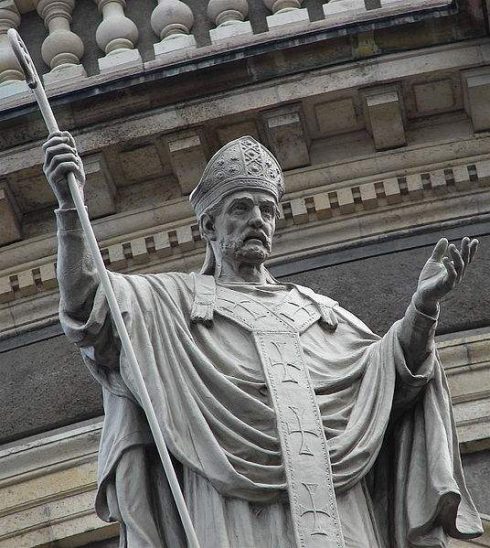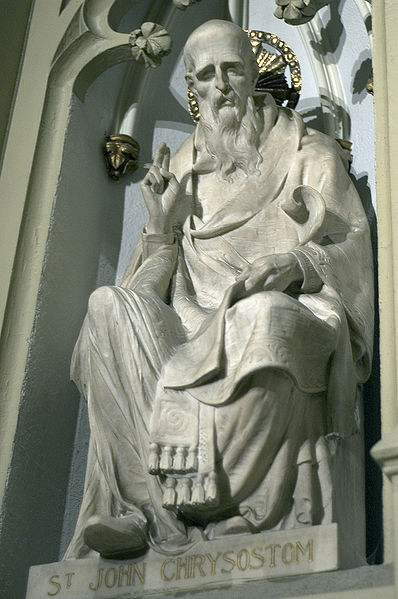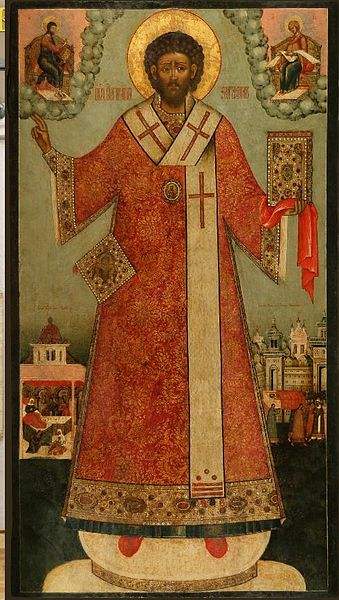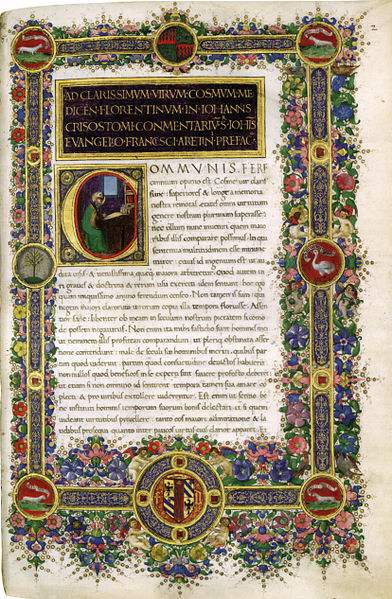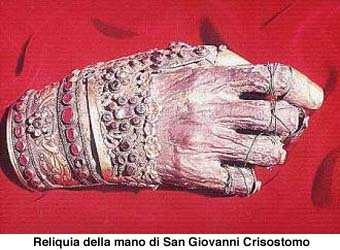St. John Chrysostom
(Chrysostomos, “golden-mouthed” so called on account of his eloquence).
Doctor of the Church, born at Antioch, c. 347; died at Commana in Pontus, 14 September, 407.
John — whose surname “Chrysostom” occurs for the first time in the “Constitution” of Pope Vigilius (cf. P.L., LX, 217) in the year 553 — is generally considered the most prominent doctor of the Greek Church and the greatest preacher ever heard in a Christian pulpit. His natural gifts, as well as exterior circumstances, helped him to become what he was.
I. LIFE
(1) Boyhood
At the time of Chrysostom’s birth, Antioch was the second city of the Eastern part of the Roman Empire. During the whole of the fourth century religious struggles had troubled the empire and had found their echo at Antioch. Pagans, Manichaeans, Gnostics, Arians, Apollinarians, Jews, made their proselytes at Antioch, and the Catholics were themselves separated by the schism between the bishops Meletius and Paulinus. Thus Chrysostom’s youth fell in troubled times. His father, Secundus, was an officer of high rank in the Syrian army. On his death soon after the birth of John, Anthusa, his wife, only twenty years of age, took the sole charge of her two children, John and an elder sister. Fortunately she was a woman of intelligence and character. She not only instructed her son in piety, but also sent him to the best schools of Antioch, though with regard to morals and religion many objections could be urged against them. Beside the lectures of Andragatius, a philosopher not otherwise known, Chrysostom followed also those of Libanius, at once the most famous orator of that period and the most tenacious adherent of the declining paganism of Rome. As we may see from the later writings of Chrysostom, he attained then considerable Greek scholarship and classical culture, which he by no means disowned in his later days. His alleged hostility to classical learning is in reality but a misunderstanding of certain passages in which he defends the philosophia of Christianity against the myths of the heathen gods, of which the chief defenders in his time were the representatives and teachers of the sophia ellenike (see A. Naegele in “Byzantin. Zeitschrift”, XIII, 73-113; Idem, “Chrysostomus und Libanius” in Chrysostomika, I, Rome, 1908, 81-142). 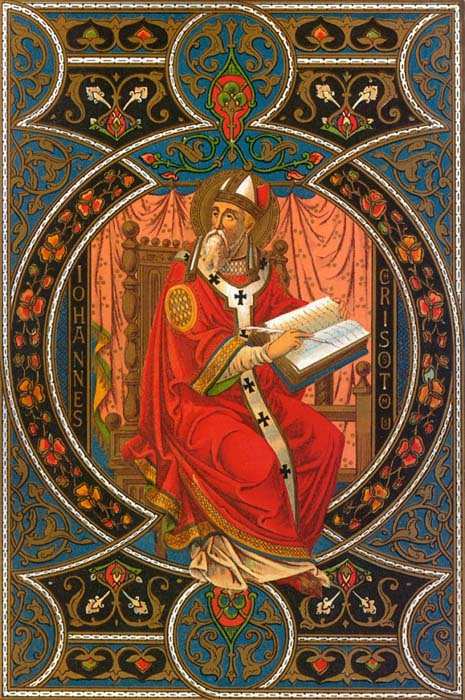
(2) Chrysostom as Lector and Monk
It was a very decisive turning-point in the life of Chrysostom when he met one day (about 367) the bishop Meletius. The earnest, mild, and winning character of this man captivated Chrysostom in such a measure that he soon began to withdraw from classical and profane studies and to devote himself to an ascetic and religious life. He studied Holy Scriptures and frequented the sermons of Meletius. About three years later he received Holy Baptism and was ordained lector. But the young cleric, seized by the desire of a more perfect life, soon afterwards entered one of the ascetic societies near Antioch, which was under the spiritual direction of Carterius and especially of the famous Diodorus, later Bishop of Tarsus (see Palladius, “Dialogus”, v; Sozomenus, “Hist. eccles.”, VIII, 2). Prayer, manual labour and the study of Holy Scripture were his chief occupations, and we may safely suppose that his first literary works date from this time, for nearly all his earlier writings deal with ascetic and monastic subjects [cf. below Chrysostom writings: (1) “Opuscuia”]. Four years later, Chrysostom resolved to live as an anchorite in one of the caves near Antioch. He remained there two years, but then as his health was quite ruined by indiscreet watchings and fastings in frost and cold, he prudently returned to Antioch to regain his health, and resumed his office as lector in the church. 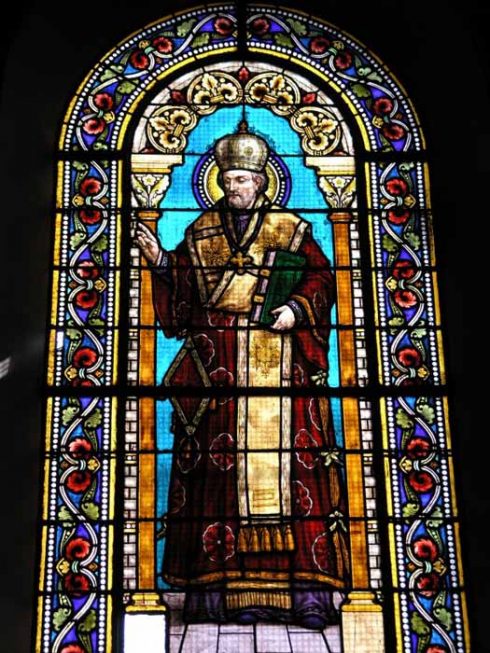
(3) Chrysostom as Deacon and Priest at Antioch
As the sources of the life of Chrysostom give an incomplete chronology, we can but approximately determine the dates for this Aniochene period. Very probably in the beginning of 381 Meletius made him deacon, just before his own departure to Constantinople, where he died as president of the Second Ecumenical Council. The successor of Meletius was Flavian (concerning whose succession see F. Cavallera, “Le Schime d’Antioche”, Paris, 1905). Ties of sympathy and friendship connected Chrysostom with his new bishop. As deacon he had to assist at the liturgical functions, to look after the sick and poor, and was probably charged also in some degree with teaching catechumens. At the same time he continued his literary work, and we may suppose that he composed his most famous book, “On the Priesthood”, towards the end of this period (c. 386, see Socrates, “Hist. eccl.”, VI, 3), or at latest in the beginning of his priesthood (c. 387, as Nairn with good reasons puts it, in his edition of “De Sacerd.”, xii-xv). There may be some doubt if it was occasioned by a real historical fact, viz., that Chrysostom and his friend Basil were requested to accept bishoprics (c. 372). All the earliest Greek biographers seem not to have taken it in that sense. In the year 386 Chrysostom was ordained priest by Flavian, and from that dates his real importance in ecclesiastical history. His chief task during the next twelve years was that of preaching, which he had to exercise either instead of or with Bishop Flavian. But no doubt the larger part of the popular religious instruction and education devolved upon him. The earliest notable occasion which showed his power of speaking and his great authority was the Lent of 387, when he delivered his sermons “On the Statues” (P.G., XLVIII, 15, xxx.). The people of Antioch, excited by the levy of new taxes, had thrown down the statues of Emperor Theodosius. In the panic and fear of punishment which followed, Chrysostom delivered a series of twenty or twenty-one (the nineteenth is probably not authentic) sermons, full of vigour, consolatory, exhortative, tranquilizing, until Flavian, the bishop, brought back from Constantinople the emperor’s pardon. But the usual preaching of Chrysostom consisted in consecutive explanations of Holy Scripture. To that custom, unhappily no longer in use, we owe his famous and magnificent commentaries, which offer us such an inexhaustible treasure of dogmatic, moral, and historical knowledge of the transition from the fourth to the fifth century. These years, 386-98, were the period of the greatest theological productivity of Chrysostom, a period which alone would have assured him for ever a place among the first Doctors of the Church. A sign of this may be seen in the fact that in the year 392 St. Jerome already accorded to the preacher of Antioch a place among his Viri illustres (“De Viris ill.”, 129, in P.L., XXIII, 754), referring expressly to the great and successful activity of Chrysostom as a theological writer. From this same fact we may infer that during this time his fame had spread far beyond the limits of Antioch, and that he was well known in the Byzantine Empire, especially in the capital.

L to R: St. Basil, St. Gregory of Nazianzus, St. John Chrysostom, St. Athanasius of Alexandria, Pope St. Clement I, St. Polycarp of Smyrna. Painting (Icon) by by Viktor Vasnetsov
(4) St. Chrysostom as Bishop of Constantinople
In the ordinary course of things Chrysostom might have become the successor of Flavian at Antioch. But on 27 September 397, Nectarius, Bishop of Constantinople, died. There was a general rivalry in the capital, openly or in secret, for the vacant see. After some months it was known, to the great disappointment of the competitors, that Emperor Areadius, at the suggestion of his minister Eutropius, had sent to the Prefect of Antioch to call John Chrysostom out of the town without the knowledge of the people, and to send him straight to Constantinople. In this sudden way Chrysostom was hurried to the capital, and ordained Bishop of Constantinople on 26 February, 398, in the presence of a great assembly of bishops, by Theophilus, Patriarch of Alexandria, who had been obliged to renounce the idea of securing the appointment of Isidore, his own candidate. The change for Chrysostom was as great as it was unexpected. His new position was not an easy one, placed as he was in the midst of an upstart metropolis, half Western, half Oriental, in the neighbourhood of a court in which luxury and intrigue always played the most prominent parts, and at the head of the clergy composed of most heterogeneous elements, and even (if not canonically, at least practically) at the head of the whole Byzantine episcopate. The first act of the new bishop was to bring about a reconciliation between Flavian and Rome. Constantinople itself soon began to feel the impulse of a new ecclesiastical life.
The necessity for reform was undeniable. Chrysostom began “sweeping the stairs from the top” (Palladius, op. cit., v). He called his oeconomus, and ordered him to reduce the expenses of the episcopal household; he put an end to the frequent banquets, and lived little less strictly than he had formerly lived as a priest and monk. With regard to the clergy, Chrysostom had at first to forbid them to keep in their houses syneisactoe, i.e. women housekeepers who had vowed virginity. He also proceeded against others who, by avarice or luxury, had given scandal. He had even to exclude from the ranks of the clergy two deacons, the one for murder and the other for adultery. Of the monks, too, who were very numerous even at that time at Constantinople, some had preferred to roam about aimlessly and without discipline. Chrysostom confined them to their monasteries. Finally he took care of the ecclesiastical widows. Some of them were living in a worldly manner: he obliged them either to marry again, or to observe the rules of decorum demanded by their state. After the clergy, Chrysostom turned his attention to his flock. As he had done at Antioch, so at Constantinople and with more reason, he frequently preached against the unreasonable extravagances of the rich, and especially against the ridiculous finery in the matter of dress affected by women whose age should have put them beyond such vanities. Some of them, the widows Marsa, Castricia, Eugraphia, known for such preposterous tastes, belonged to the court circle. It seems that the upper classes of Constantinople had not previously been accustomed to such language. Doubtless some felt the rebuke to be intended for themselves, and the offence given was the greater in proportion as the rebuke was the more deserved. On the other hand, the people showed themselves delighted with the sermons of their new bishop, and frequently applauded him in the church (Socrates, “Hist. eccl.” VI). They never forgot his care for the poor and miserable, and that in his first year he had built a great hospital with the money he had saved in his household. But Chrysostom had also very intimate friends among the rich and noble classes. The most famous of these was Olympias, widow and deaconess, a relation of Emperor Theodosius, while in the Court itself there was Brison, first usher of Eudoxia, who assisted Chrysostom in instructing his choirs, and always maintained a true friendship for him. The empress herself was at first most friendly towards the new bishop. She followed the religious processions, attended his sermons, and presented silver candlesticks for the use of the churches (Socrates, op. cit., VI, 8; Sozomenus, op. cit., VIII, 8).
Unfortunately, the feelings of amity did not last. At first Eutropius, the former slave, now minister and consul, abused his influence. He deprived some wealthy persons of their property, and prosecuted others whom he suspected of being adversaries of rivals. More than once Chrysostom went himself to the minister (see “Oratio ad Eutropium” in P.G., Chrys. Op., III, 392) to remonstrate with him, and to warn him of the results of his own acts, but without success. Then the above-named ladies, who immediately surrounded the empress, probably did not hide their resentment against the strict bishop. Finally, the empress herself committed an injustice in depriving a widow of her vineyard (Marcus Diac., “Vita Porphyrii”, V, no. 37, in P.G., LXV, 1229). Chrysostom interceded for the latter. But Eudoxia showed herself offended. Henceforth there was a certain coolness between the imperial Court and the episcopal palace, which, growing little by little, led to a catastrophe. It is impossible to ascertain exactly at what period this alienation first began; very probably it dated from the beginning of the year 401. But before this state of things became known to the public there happened events of the highest political importance, and Chrysostom, without seeking it, was implicated in them. These were the fall of Eutropius and the revolt of Gainas.
In January, 399, Eutropius, for a reason not exactly known, fell into disgrace. Knowing the feelings of the people and of his personal enemies, he fled to the church. As he had himself attempted to abolish the immunity of the ecclesiastical asylums not long before, the people seemed little disposed to spare him. But Chrysostom interfered, delivering his famous sermon on Eutropius, and the fallen minister was saved for the moment. As, however, he tried to escape during the night, he was seized, exiled, and some time later put to death. Immediately another more exciting and more dangerous event followed. Gainas, one of the imperial generals, had been sent out to subdue Tribigild, who had revolted. In the summer of 399 Gainas united openly with Tribigild, and, to restore peace, Arcadius had to submit to the most humiliating conditions. Gainas was named commander-in-chief of the imperial army, and even had Aurelian and Saturninus, two men of the highest rank at Constantinople, delivered over to him. It seems that Chrysostom accepted a mission to Gainas, and that, owing to his intervention, Aurelian and Saturninus were spared by Gainas, and even set at liberty. Soon afterwards, Gainas, who was an Arian Goth, demanded one of the Catholic churches at Constantinople for himself and his soldiers. Again Chrysostom made so energetic an opposition that Gainas yielded. Meanwhile the people of Constantinople had become excited, and in one night several thousand Goths were slain. Gainas however escaped, was defeated, and slain by the Huns. Such was the end within a few years of three consuls of the Byzantine Empire. There is no doubt that Chrysostom’s authority had been greatly strengthened by the magnanimity and firmness of character he had shown during all these troubles. It may have been this that augmented the jealousy of those who now governed the empire — a clique of courtiers, with the empress at their head. These were now joined by new allies issuing from the ecclesiastical ranks and including some provincial bishops — Severian of Gabala, Antiochus of Ptolemais, and, for some time, Acacius of Beroea — who preferred the attractions of the capital to residence in their own cities (Socrates, op. cit., VI, 11; Sozomenus, op. cit., VIII, 10). The most intriguing among them was Severian, who flattered himself that he was the rival of Chrysostom in eloquence. But so far nothing had transpired in public. A great change occurred during the absence of Chrysostom for several months from Constantinople. This absence was necessitated by an ecclesiastical affair in Asia Minor, in which he was involved. Following the express invitation of several bishops, Chrysostom, in the first months of 401, had come to Ephesus, where he appointed a new archbishop, and with the consent of the assembled bishops deposed six bishops for simony. After having passed the same sentence on Bishop Gerontius of Nicomedia, he returned to Constantinople.
Meanwhile disagreeable things had happened there. Bishop Severian, to whom Chrysostom seems to have entrusted the performance of some ecclesiastical functions, had entered into open enmity with Serapion, the archdeacon and oeconomus of the cathedral and the episcopal palace. Whatever the real reason may have been, Chrysostom, found the case so serious that he invited Severian to return to his own see. It was solely owing to the personal interference of Eudoxia, whose confidence Serapion possessed, that he was allowed to come back from Chalcedon, whither he had retired. The reconciliation which followed was, at least on the part of Severian, not a sincere one, and the public scandal had excited much ill-feeling. The effects soon became visible. When in the spring of 402, Bishop Porphyrius of Gaza (see Marcus Diac., “Vita Porphyrii”, V, ed. Nuth, Bonn, 1897, pp. 11-19) went to the Court at Constantinople to obtain a favour for his diocese, Chrysostom answered that he could do nothing for him, since he was himself in disgrace with the empress. Nevertheless, the party of malcontents were not really dangerous, unless they could find some prominent and unscrupulous leader. Such a person presented himself sooner than might have been expected. It was the well-known Theophilus, Patriarch of Alexandria. He appeared under rather curious circumstances, which in no way foreshadowed the final result. Theophilus, toward the end of the year 402, was summoned by the emperor to Constantinople to apologize before a synod, over which Chrysostom should preside, for several charges, which were brought against him by certain Egyptian monks, especially by the so-called four “tall brothers”. The patriarch, their former friend, had suddenly turned against them, and had them persecuted as Origenists (Palladius, “Dialogus”, xvi; Socrates, op. cit., VI, 7; Sozomenus, op. cit., VIII, 12).
However, Theophilus was not easily frightened. He had always agents and friends at Constantinople, and knew the state of things and the feelings at the court. He now resolved to take advantage of them. He wrote at once to St. Epiphanius at Cyprus, requesting him to go to Constantinople and prevail upon Chrysostom at to condemn the Origenists. Epiphanius went. But when he found that Theophilus was merely using him for his own purposes, he left the capital, dying on his return in 403. At this time Chrysostom delivered a sermon against the vain luxury of women. It was reported to the empress as though she had been personally alluded to. In this way the ground was prepared. Theophilus at last appeared at Constantinople in June, 403, not alone, as he had been commanded, but with twenty-nine of his suffragan bishops, and, as Palladius (ch. viii) tells us, with a good deal of money and all sorts of gifts.  He took his lodgings in one of the imperial palaces, and held conferences with all the adversaries of Chrysostom. Then he retired with his suffragans and seven other bishops to a villa near Constantinople, called epi dryn (see Ubaldi, “La Synodo ad Quercum”, Turin, 1902). A long list of the most ridiculous accusations was drawn up against Chrysostom (see Photius, “Bibliotheca”, 59, in P.G., CIII, 105-113), who, surrounded by fourty-two archbishops and bishops assembled to judge Theophilus in accordance with the orders of the emperor, was now summoned to present himself and apologize. Chrysostom naturally refused to recognize the legality of a synod in which his open enemies were judges. After the third summons Chrysostom, with the consent of the emperor, was declared to be deposed. In order to avoid useless bloodshed, he surrendered himself on the third day to the soldiers who awaited him. But the threats of the excited people, and a sudden accident in the imperial palace, frightened the empress (Palladius, “Dialogus”, ix). She feared some punishment from heaven for Chrysostom’s exile, and immediately ordered his recall. After some hesitation Chrysostom re-entered the capital amid the great rejoicings of the people. Theophilus and his party saved themselves by flying from Constantinople. Chrysostom’s return was in itself a defeat for Eudoxia. When her alarms had gone, her rancour revived. Two months afterwards a silver statue of the empress was unveiled in the square just before the cathedral. The public celebrations which attended this incident, and lasted several days, became so boisterous that the offices in the church were disturbed. Chrysostom complained of this to the prefect of the city, who reported to Eudoxia that the bishop had complained against her statue. This was enough to excite the empress beyond all bounds. She summoned Theophilus and the other bishops to come back and to depose Chrysostom again. The prudent patriarch, however, did not wish to run the same risk a second time. He only wrote to Constantinople that Chrysostom should be condemned for having re-entered his see in opposition to an article of the Synod of Antioch held in the year 341 (an Arian synod). The other bishops had neither the authority nor the courage to give a formal judgment. All they could do was to urge the emperor to sign a new decree of exile. A double attempt on Chrysostom’s life failed. On Easter Eve, 404, when all the catechumens were to receive baptism, the adversaries of the bishop, with imperial soldiers, invaded the baptistery and dispersed the whole congregation. At last Arcadius signed the decree, and on 24 June, 404, the soldiers conducted Chrysostom a second time into exile.
He took his lodgings in one of the imperial palaces, and held conferences with all the adversaries of Chrysostom. Then he retired with his suffragans and seven other bishops to a villa near Constantinople, called epi dryn (see Ubaldi, “La Synodo ad Quercum”, Turin, 1902). A long list of the most ridiculous accusations was drawn up against Chrysostom (see Photius, “Bibliotheca”, 59, in P.G., CIII, 105-113), who, surrounded by fourty-two archbishops and bishops assembled to judge Theophilus in accordance with the orders of the emperor, was now summoned to present himself and apologize. Chrysostom naturally refused to recognize the legality of a synod in which his open enemies were judges. After the third summons Chrysostom, with the consent of the emperor, was declared to be deposed. In order to avoid useless bloodshed, he surrendered himself on the third day to the soldiers who awaited him. But the threats of the excited people, and a sudden accident in the imperial palace, frightened the empress (Palladius, “Dialogus”, ix). She feared some punishment from heaven for Chrysostom’s exile, and immediately ordered his recall. After some hesitation Chrysostom re-entered the capital amid the great rejoicings of the people. Theophilus and his party saved themselves by flying from Constantinople. Chrysostom’s return was in itself a defeat for Eudoxia. When her alarms had gone, her rancour revived. Two months afterwards a silver statue of the empress was unveiled in the square just before the cathedral. The public celebrations which attended this incident, and lasted several days, became so boisterous that the offices in the church were disturbed. Chrysostom complained of this to the prefect of the city, who reported to Eudoxia that the bishop had complained against her statue. This was enough to excite the empress beyond all bounds. She summoned Theophilus and the other bishops to come back and to depose Chrysostom again. The prudent patriarch, however, did not wish to run the same risk a second time. He only wrote to Constantinople that Chrysostom should be condemned for having re-entered his see in opposition to an article of the Synod of Antioch held in the year 341 (an Arian synod). The other bishops had neither the authority nor the courage to give a formal judgment. All they could do was to urge the emperor to sign a new decree of exile. A double attempt on Chrysostom’s life failed. On Easter Eve, 404, when all the catechumens were to receive baptism, the adversaries of the bishop, with imperial soldiers, invaded the baptistery and dispersed the whole congregation. At last Arcadius signed the decree, and on 24 June, 404, the soldiers conducted Chrysostom a second time into exile.
(5) Exile and Death
They had scarcely left Constantinople when a huge conflagration destroyed the cathedral, the senate-house, and other buildings. The followers of the exiled bishop were accused of the crime and prosecuted. In haste Arsacius, an old man, was appointed successor of Chrysostom, but was soon succeeded by the cunning Atticus. Whoever refused to enter into communion with them was punished by confiscation of property and exile. Chrysostom himself was conducted to Cucusus, a secluded and rugged place on the east frontier of Armenia, continually exposed to the invasions of the Isaurians. In the following year he had even to fly for some time to the castle of Arabissus to protect himself from these barbarians. Meanwhile he always maintained a correspondence with his friends and never gave up the hope of return. When the circumstances of his deposition were known in the West, the pope and the Italian bishops declared themselves in his favour. Emperor Honorius and Pope Innocent I endeavoured to summon a new synod, but their legates were imprisoned and then sent home. The pope broke off all communion with the Patriarchs of Alexandria, Antioch (where an enemy of Chrysostom had succeeded Flavian), and Constantinople, until (after the death of Chrysostom) they consented to admit his name into the diptychs of the Church. Finally all hopes for the exiled bishop had vanished. Apparently he was living too long for his adversaries. In the summer, 407, the order was given to carry him to Pithyus, a place at the extreme boundary of the empire, near the Caucasus. One of the two soldiers who had to lead him caused him all possible sufferings. He was forced to make long marches, was exposed to the rays of the sun, to the rains and the cold of the nights. His body, already weakened by several severe illnesses, finally broke down. On 14 September the party were at Comanan in Pontus. In the morning Chrysostom had asked to rest there on the account of his state of health. In vain; he was forced to continue his march. Very soon he felt so weak that they had to return to Comana. Some hours later Chrysostom died. His last words were: Doxa to theo panton eneken (Glory be to God for all things) (Palladius, xi, 38). He was buried at Comana. On 27 January, 438, his body was translated to Constantinople with great pomp, and entombed in the church of the Apostles where Eudoxia had been buried in the year 404 (see Socrates, VII, 45; Constantine Prophyrogen., “Cæremoniale Aul Byz.”, II, 92, in P.G., CXII, 1204 B).
II. THE WRITINGS OF ST. CHRYSOSTOM
Chrysostom has deserved a place in ecclesiastical history, not simply as Bishop of Constantinople, but chiefly as a Doctor of the Church. Of none of the other Greek Fathers do we possess so many writings. We may divide them into three portions, the “opuscula”, the “homilies”, and the “letters”. (1) The chief “opuscula” all date from the earlier days of his literary activity. The following deal with monastical subjects: “Comparatio Regis cum Monacho” (“Opera”, I, 387-93, in P.G., XLVII-LXIII), “Adhortatio ad Theodorum (Mopsuestensem?) lapsum” (ibid., 277-319), “Adversus oppugnatores vitae monasticae” (ibid., 319-87). Those dealing with ascetical subjects in general are the treatise “De Compunctione” in two books (ibid., 393-423), “Adhortatio ad Stagirium” in three books (ibid., 433-94), “Adversus Subintroductas” (ibid., 495-532), “De Virginitate” (ibid., 533-93), “De Sacerdotio” (ibid., 623-93). (2) Among the “homilies” we have to distinguish commentaries on books of Holy Scripture, groups of homilies (sermons) on special subjects, and a great number of single homilies. (a) The chief “commentaries” on the Old Testament are the sixty-seven homilies “On Genesis” (with eight sermons on Genesis, which are probably a first recension) (IV, 21 sqq., and ibid., 607 sqq.); fifty-nine homilies “On the Psalms” (4-12, 41, 43-49, 108-117, 119-150) (V, 39-498), concerning which see Chrys. Baur, “Der urspr ngliche Umfang des Kommentars des hl. Joh. Chrysostomus zu den Psalmen” in Chrysostomika, fase. i (Rome, 1908), 235-42, a commentary on the first chapters of “Isaias” (VI, 11 sqq.). The fragments on Job (XIII, 503-65) are spurious (see Haidacher, “Chrysostomus Fragmente” in Chrysostomika, I, 217 sq.); the authenticity of the fragments on the Proverbs (XIII, 659-740), on Jeremias and Daniel (VI, 193-246), and the Synopsis of the Old and the New Testament (ibid., 313 sqq.), is doubtful. The chief commentaries on the New Testament are first the ninety homilies on “St. Matthew” (about the year 390; VII), eighty-eight homilies on “St. John” (c. 389; VIII, 23 sqq. — probably from a later edition), fifty-five homilies on “the Acts” (as preserved by stenographers, IX, 13 sqq.), and homilies “On all Epistles of St. Paul” (IX, 391 sqq.). The best and most important commentaries are those on the Psalms, on St. Matthew, and on the Epistle to the Romans (written c. 391). The thirty-four homilies on the Epistle to the Galatians also very probably comes to us from the hand of a second editor. (b) Among the “homilies forming connected groups”, we may especially mention the five homilies “On Anna” (IV, 631-76), three “On David” (ibid., 675-708), six “On Ozias” (VI, 97-142), eight “Against the Jews” (II, 843-942), twelve “De Incomprehensibili Dei Natur ” (ibid., 701-812), and the seven famous homilies “On St. Paul” (III, 473-514). (c) A great number of “single homilies” deal with moral subjects, with certain feasts or saints. (3) The “Letters” of Chrysostom (about 238 in number: III, 547 sqq.) were all written during his exile. Of special value for their contents and intimate nature are the seventeen letters to the deaconess Olympias. Among the numerous “Apocrypha” we may mention the liturgy attributed to Chrysostom, who perhaps modified, but did not compose the ancient text. The most famous apocryphon is the “Letter to C sarius” (III, 755-760). It contains a passage on the holy Eucharist which seems to favour the theory of “impanatio”, and the disputes about it have continued for more than two centuries. The most important spurious work in Latin is the “Opus imperfectum”, written by an Arian in the first half of the fifth century (see Th. Paas, “Das Opus impefectum in Matthæum”, Tübingen, 1907).
III. CHRYSOSTOM’S THEOLOGICAL IMPORTANCE
(1) Chrysostom as Orator
The success of Chrysostom’s preaching is chiefly due to his great natural facility of speech, which was extraordinary even to Greeks, to the abundance of his thoughts as well as the popular way of presenting and illustrating them, and, last but not least, the whole-hearted earnestness and conviction with which he delivered the message which he felt had been given to him. Speculative explanation did not attract his mind, nor would they have suited the tastes of his hearers. He ordinarily preferred moral subjects, and very seldom in his sermons followed a regular plan, nor did he care to avoid digressions when any opportunity suggested them. In this way, he is by no means a model for our modern thematic preaching, which, however we may regret it, has to such a great extent supplanted the old homiletic method. But the frequent outbursts of applause among his congregation may have told Chrysostom that he was on the right path.
(2) Chrysostom as an exegete
As an exegete Chrysostom is of the highest importance, for he is the chief and almost the only successful representative of the exegetical principles of the School of Antioch. Diodorus of Tarsus had initiated him into the grammatico-historical method of that school, which was in strong opposition to the eccentric, allegorical, and mystical interpretation of Origen and the Alexandrian School. But Chrysostom rightly avoided pushing his principles to that extreme to which, later on, his friend Theodore of Mopsuestia, the teacher of Nestorius, carried them. He did not even exclude all allegorical or mystical explanations, but confined them to the cases in which the inspired author himself suggests this meaning.
(3) Chrysostom as Dogmatic Theologian
As has already been said, Chrysostom’s was not a speculative mind, nor was he involved in his lifetime in great dogmatic controversies. Nevertheless it would be a mistake to underrate the great theological treasures hidden in his writings. From the very first he was considered by the Greeks and Latins as a most important witness to the Faith. Even at the Council of Ephesus (431) both parties, St. Cyril and the Antiochians, already invoked him on behalf of their opinions, and at the Seventh Ecumenical Council, when a passage of Chrysostom had been read in favour of the veneration of images, Bishop Peter of Nicomedia cried out: “If John Chrysostom speaks in the way of the images, who would dare to speak against them?” which shows clearly the progress his authority had made up to that date.
Strangely enough, in the Latin Church, Chrysostom was still earlier invoked as an authority on matters of faith. The first writer who quoted him was Pelagius, when he wrote his lost book “De Naturæ” against St. Augustine (c. 415). The Bishop of Hippo himself very soon afterwards (421) claimed Chrysostom for the Catholic teaching in his controversy with Julian of Eclanum, who had opposed to him a passage of Chrysostom (from the “Hom. ad Neophytos”, preserved only in Latin) as being against original sin (see Chrys. Baur, “L’entrée littéraire de St. Jean Chrys. dans le monde latin” in the “Revue d’histoire ecclés.”, VIII, 1907, 249-65). Again, at the time of the Reformation there arose long and acrid discussions as to whether Chrysostom was a Protestant or a Catholic, and these polemics have never wholly ceased. It is true that Chrysostom has some strange passages on our Blessed Lady (see Newman, “Certain difficulties felt by Anglicans in Catholic Teachings”, London, 1876, pp. 130 sqq.), that he seems to ignore private confession to a priest, that there is no clear and any direct passage in favour of the primacy of the pope. But it must be remembered that all the respective passages contain nothing positive against the actual Catholic doctrine. On the other side Chrysostom explicitly acknowledges as a rule of faith tradition (XI, 488), as laid down by the authoritative teaching of the Church (I, 813). This Church, he says, is but one, by the unity of her doctrine (V, 244; XI, 554); she is spread over the whole world, she is the one Bride of Christ (III, 229, 403; V, 62; VIII, 170). As to Christology, Chrysostom holds clearly that Christ is God and man in one person, but he never enters into deeper examination of the manner of this union. Of great importance is his doctrine regarding the Eucharist. There cannot be the slightest doubt that he teaches the Real Presence, and his expressions on the change wrought by the words of the priest are equivalent to the doctrine of transubstantiation (see Naegle, “Die Eucharistielehre des hl. Joh. Chry.”, 74 sq.).
A complete analysis and critique of the enormous literature on Chrysostom (from the sixteenth century to the twentieth) is given in BAUR, S. Jean Chrysostome et ses oeuvres dans l’histoire litt raire (Paris and Louvain, 1907), 223-297.
(1) LIFE OF CHRYSOSTOM. (a) Sources. — PALLADIUS, Dialogue cum Theodoro, Ecclesioe Romanoe Diacono, de vit et conversatione b. Joh. Chrysostomi(written c. 408; best source; ed. BIGOT, Paris, 1680; P.G., XLVII, 5-82) MARTYRIUS, Panegyricus in S. Joh. Chrysostomum (written c. 408; ed. P.G., loc. cit., XLI-LII); SOCRATES, Hist. Eccl., VI, 2-23, and VII, 23, 45 (P.G., LXVII, 661 sqq.); SOZOMENUS, Hist. eccl., VIII, 2-28 (P.G.,ibid., 1513 sqq.), more complete than Socrates, on whom he is dependent; THEODORET, Hist. eccl., V, 27-36; P.G., LXXXII, 1256-68, not always reliable; ZOSIMUS, V, 23-4 (ed. BEKKER, p. 278-80, Bonn. 1837), not trustworthy.
(b) Later Authors. — THEODORE OF THRIMITUS, (P.G., XLVII, col. 51-88), without value, written about the end of the seventh century; (PSEUDO-) GEORGIUS ALEXANDRINUS, ed. SAVILE, Chrys. opera omnia (Eton, 1612), VIII, 157-265 (8th – 9th century); LEO IMPERATOR, Laudatio Chrys. (P.G., CVII, 228 sqq.); ANONYMUS, (ed. SAVILE, loc. cit., 293-371); SYMEON METAPHRASTES, (P.G., CXIV, 1045-1209).
(c) Modern Biographies. — English: STEPHENS, Saint John Chrysostom, his life and times, a sketch of the Church and the empire in the fourth century (London, 1871; 2nd ed., London, 1880), the best English biography, but it anglicanizes the doctrine of Chrysostom; BUSH, The Life and Times of Chrysostom (London, 1885), a popular treatise. French: HERMANT, La Vie de Saint Jean Chrysostome . . . divis e en 12 livres (Paris, 1664; 3rd ed., Paris, 1683), the first scientific biography; DE TILLEMONT, Mémoires pour servir l’histoire ecclésiastique des six premiers si cles, XI, 1-405, 547-626 (important for the chronology); STILTING, De S. Jo. Chrysostomo . . . Commentarius historicus in Acta SS., IV, Sept., 401-700 (1st ed., 1753), best scientific biography in Latin; THIERRY, S. Jean Chrysostome et l’imp ratrice Eudoxie (Paris, 1872; 3rd ed., Paris, 1889), “more romance than history”; PUECH, Saint Jean Chrysostome (Paris, 1900); 5th ed., Paris, 1905), popular and to be read with caution. German: NEANDER, Der hl. Joh. Chrysostomus und die Kirche, besonders des Orients, in dessen Zeitalter, 2 vols. (Berlin, 1821 – 22; 4th ed., Berlin 1858); first vol., translated into English by STAPLETON (London, 1838), gives an account of the doctrine of Chrysostom with Protestant views; LUDWIG, Der hl. Joh. Chrys. in seinem Verh liniss zum byzantinischen Hof. (Braunsberg, 1883), scientific. Chrysostom as orator: ALBERT, S. Jean Chrysostome consid r comme orateur populaire (Paris, 1858); ACKERMANN, Die Beredsamkeit des hl. Joh. Chrys. (W rzburg, 1889); cf. WILLEY, Chrysostom: The Orator (Cincinnati, 1908), popular essay.
(2) CHRYSOSTOM’S WRITINGS. (a) Chronology. — See TILLEMONT, STILTING, MONTFAUCON, Chrys. Opera omnia; USENER, Religionsgeschichtliche Untersuchungen, I (Bonn, 1889), 514-40; RAUSCHEN, Jahrb cher der christl. Kirche unter dem Kaiser Theodosius dem Grossen (Freiburg im Br., 1897), 251-3, 277-9, 495-9; BATIFFOL, Revue bibl., VIII, 566-72; PARGOIRE, Echos d’Orient, III 151-2; E. SCHARTZ, J dische und chrisl. Ostertafeln (Berlin, 1905), 169-84.
(b) Authenticity. — HAIDACHER, Zeitschr. f r Kath. Theologie, XVIII-XXXII; IDEM, Deshl. Joh. Chrys. Buchlein ber Hoffart u. Kindererziehung (Freiburg, im Br., 1907).
(3) CHRYSOSTOM’S DOCTRINE. MAYERUS, Chrysostomus Lutheranus (Grimma, 1680: Wittenberg, 1686); HACKI, D. Jo. Chrysostomus . . . a Lutheranismo . . . vindicatus (Oliva, 1683); F RSTER, Chrysostomus in seinem Verh ltniss zur antiochen. Schule (Gotha, 1869); CHASE, Chrysostom, A Study in the History of Biblical Interpretation (London, 1887); HAIDACHER, Die Lehre des hl. Joh. Chrys. ber die Schriftinspiration (Salzburg, 1897); CHAPMAN, St. Chrysostom on St. Peter in Dublin Review (1903), 1-27; NAEGLE, Die Eucharistielehre des hl. Johannes Chrysostomus, des Doctor Eucharisti (Freiburg im Br., 1900).
(4) EDITIONS. (a) Complete. — SAVILE (Eton, 1612), 8 volumes (the best text); DUCAEUS, (Paris, 1609-1636), 12 vols.; DE MONTFAUCON, (Paris, 1718-1738), 13 vols.; MIGNE, P.G., XLVII – LXIII.
(b) Partial. — FIELD, Homilies in Matth. (Cambridge, 1839), 3 vols., best actual text reprinted in MIGNE, LVII – LVIII; IDEM, Homilioe in omnes epistolas Pauli (Oxford, 1845-62), VII. The last critical edition of the De Sacerdotio was edited by NAIRN (Cambridge, 1906). There exist about 54 complete editions (in five languages), 86 percent special editions of De Sacerdotio (in twelve languages), and the whole number of all (complete and special) editions is greatly over 1000. The oldest editions are the Latin; of which forty-six different incunabula editions (before the year 1500) exist. See DIODORUS OF TARSUS, METETIUS OF ANTIOCH, ORIGENISTS, PALLADIUS, THEODORE OF MOPSUESTIA.
Chrys. Baur
